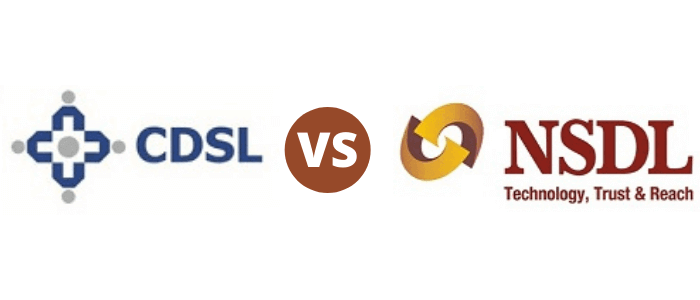
In India, there are two electronic depositories for keeping securities: CDSL and NSDL. The National Securities Depository Ltd (NSDL) was India’s first depository. It was founded in 1996. CDSL (Central Depositories Services India Ltd.) was established in 1999. Both securities are headquartered in Mumbai, Maharashtra. The depository for the National Stock Exchange (NSE) and the Bombay Stock Exchange (BSE) is NSDL and CDSL, respectively. Both depositories are government-registered and keep securities in electronic forms, such as stocks, bonds, ETFs, MFs, and shares. However, there are some distinctions. Let’s look at a CDSL versus NSDL comparison.
Difference Between CDSL and NSDL.
Both CDSL and NSDL are electronic depositories of India, so there is not much difference between the two. But we have told you about the difference between CDSL and NSDL through the table below.
| CDSL Depository | NSDL Depository |
|---|---|
| The full form of CDSL is Central Depository Services Limited. | The full form of NSDL is National Securities Depository Limited. |
| CDSL is India’s second electronic depository. | NSDL is India’s first electronic depository. |
| CDSL was established in February 1999. | NSDL was established on 8 November 1996. |
| CDSL Depository works for BSE. | NSDL Depository works for NSE. |
| If your Demat account is in CDSL then your ID will have 16 digits. | If you have a Demat account in NSDL, then your ID will start with IN and the rest will be 14 numbers. |
| There are different charges for opening an account with CDSL Depository. | The fee for opening an account with the NSDL depository varies. |
| CDSL depositories charge their investors separately with debit instructions. | NSDL depositories charge their investors different fees along with debit instructions. |
What is CDSL (Central Depository Services Limited)?
Central Depository Services Limited is the country’s second securities depository. CDSL was created in 1999 and holds a variety of securities in electronic form, including shares, bonds, and more. It primarily serves as a repository for the Bombay Stock Exchange (BSE). Their promoters include major Indian banks such as the State Bank of India, Union Bank of India, and Axis Bank. Other well-known institutions, including HDFC Bank, Bank of Baroda, and Standard Chartered Bank, have stakes in them as well. It is also the first depository to have more than 30 million investor accounts. It has around 588 Depository Participants. CDSL’s major mission is to provide Convenient, Reliable, and Secure depository services. It operates in the same manner as a bank.
What is the role of CDSL?
The roles of CDSL are as follows:
- Maintainance of Demat accounts.
- Rematerialization and dematerialization.
- Trades are settled.
- Transfers on and off the market Opening account.
- Transfer of stock.
- Nomination/Transmission.
- Non-cash corporate actions are distributed.
- Accounts statement.
- Account information is being changed.
- Information on shareholders is shared with companies.
- Dividend payout details are being shared.
What is NSDL (National Securities Depository Limited)?
The National Securities Depository Limited (NSDL) is India’s oldest depository institution, having been established in August 1996. It is an electronic securities depository that stores securities such as shares, bonds, and other financial instruments in electronic form. Because of electronic securities, management is relatively simple. Furthermore, NSDL is comparable to banks. The main distinction between NSDL and banks is that NSDL holds securities whereas banks have depositors’ money. Its promoters are the National Stock Exchange (NSE), the Industrial Development Bank of India (IDBI), and the Unit Trust of India (UTI). NSDL also offers a number of share-related services. To use NSDL’s services, please click here.
What are the functions of NDLS?
NSDL’s functions are as follows:
- Allow for the surrender and withdrawal of securities (Dematerialization and Rematerialisation).
- Keeps investors’ holdings in electronic form.
- Participated in stock lending and borrowing.
- Facilitates the transfer of securities.
- Securities settlement.
- Allows for the mortgaging of securities for loan purposes.
- Allows for electronic crediting of shares in public offerings.
Conclusion:
The differences between CDSL and NSDL are minimal. They both operate in the same manner, providing customers with identical services supervised by SEBI. They also have some minor differences, such as account numbers or years of operation.



